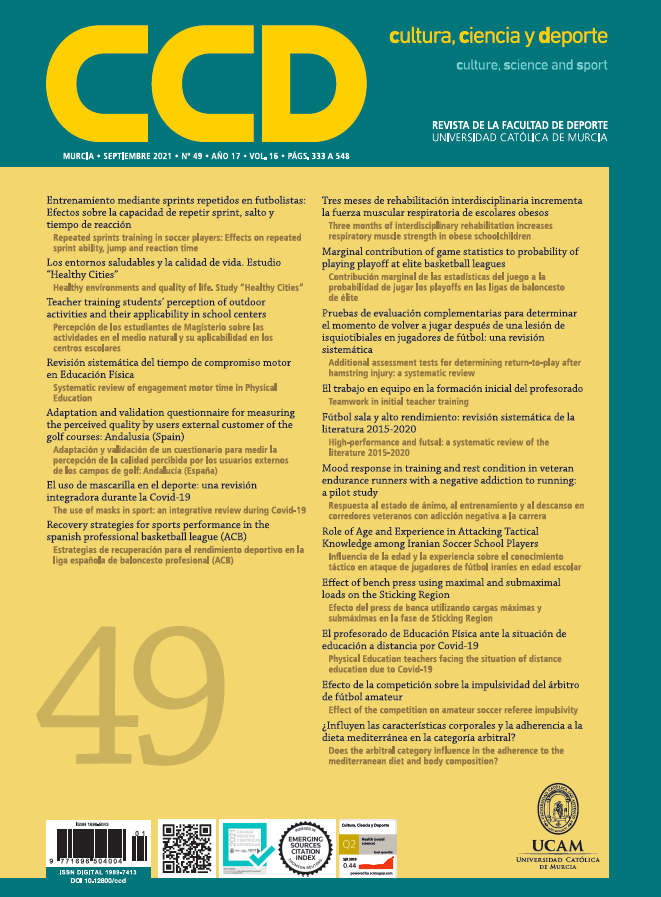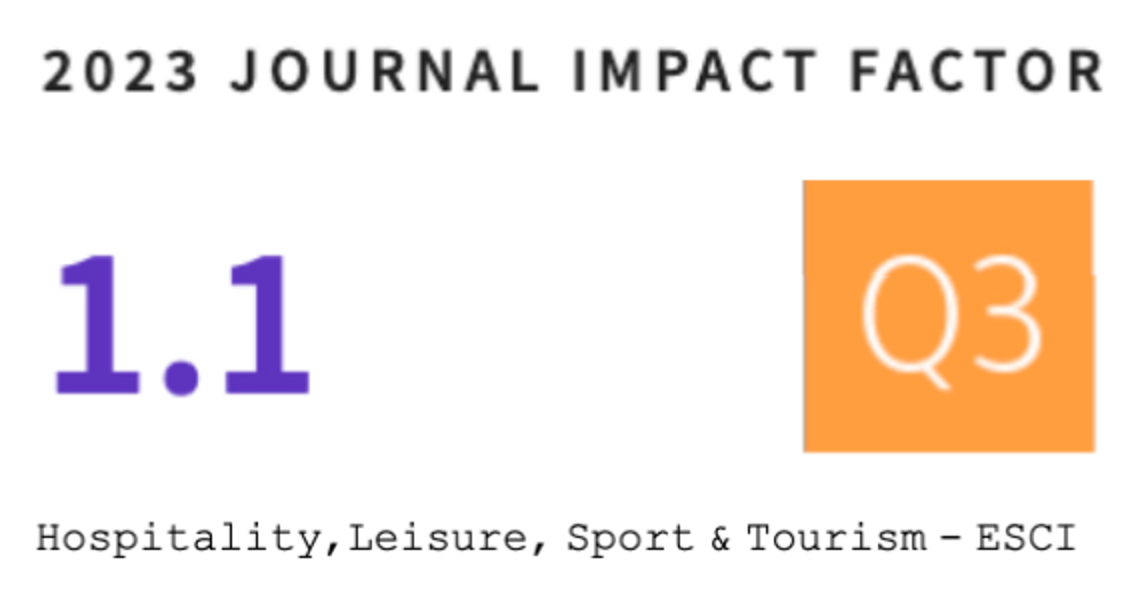Contribución marginal de las estadísticas del juego a la probabilidad de jugar los playoffs en las ligas de baloncesto de élite
DOI:
https://doi.org/10.12800/ccd.v16i49.1586Keywords:
Basketball, performance analysis, game-related statistics, sport analytics.Abstract
La aplicación del análisis multinivel de efectos mixtos logísticos ordinales se muestra como una herramienta de apoyo a la gestión del baloncesto para identificar las estadísticas de juego que discriminan la posición final en la clasificación en temporada regular. Se tomaron datos de 10684 partidos que abarcan 10 temporadas y alcanzan la muestra de 752 casos de las dos principales ligas españolas (masculino y femenino). El análisis multinivel aplicado, identifica los efectos marginales de principales variables evaluadas por los entrenadores de baloncesto, que pueden ayudarles a mejorar el rendimiento de sus equipos. Los resultados muestran que, para los equipos localizados en la zona de descenso, la contribución marginal de los porcentajes de tiros de campo, rebote defensivo, robos y pérdidas de balón fue de 8,3 puntos porcentuales (pp), 7 pp, 9,6 pp y 8,6 pp respectivamente, mayor que en los equipos en zona de Play-off (p <0,01). El modelo aplicado aporta una contribución significativa a la literatura al identificar una metodología que puede extenderse directamente para una evaluación en el puesto clasificatorio de los equipos, ayudando de esta manera a los entrenadores a tomar decisiones importantes, como discriminar jerárquicamente qué factores son los más relevantes, tanto para evitar la zona de descenso y acceder a la zona de playoff.
References
Bradbury, J. C. (2019). Determinants of revenue in sports leagues: An empirical assessment. Economic Inquiry, 57(1), 121-140. doi:10.1111/ecin.12710
Fernández García, Á. I., Blanca-Torres, J. C., Hernández-García, R., & Torres-Luque, G. (2019). Análisis de las variables estadísticas relacionadas con el servicio en tenis masculino de alto rendimiento en categoría junior y absoluto. Cultura, Ciencia y Deporte, 14(42), 289-295. doi:10.12800/ccd.v14i42.1342
García, J., Ibáñez, S. J., & Feu, S. (2010). Game statistics that discriminate the national teams partipating in the 2006 World Basketball Championship, regarding the level and the gender of the teams. Kronos, 9(17), 57-63.
García-Manso, J. M., Arriaza, A., Martínez-González, J. M., Ramos-Verde, E., Díaz-Díaz, R., & García-Roca, J. A. (2020). What makes Elite Leagues Profesional? Cultura, Ciencia y Deporte, 15(45), 303-311. doi:10.12800/ccd.v15i45.1508
Gelman, A., & Pardoe, I. (2007). Average predictive comparisons for models with nonlinearity, interactions, and variance components. Sociological Methodology, 37(1), 23-51. doi:10.1111/j.1467-9531.2007.00181.x
Glasgow, P., & Mutch, S. (2019). Twists, Turns & Entanglement – Complexity and the tricky challenges of sport for the athlete and practitioner. British Journal of Sports Medicine, 53(19), 1197-1197. doi:10.1136/bjsports-2019-101518
Goldstein, H. (2003). Multilevel modelling of educational data Methodology and epistemology of multilevel analysis (pp. 25-42): Springer.
Gutiérrez, Ó., & Ruiz, J. L. (2013). Data envelopment analysis and cross-efficiency evaluation in the management of sports teams: the assessment of game performance of players in the Spanish handball league. Journal of Sport Management, 27(3), 217-229. doi:10.1123/jsm.27.3.217
Gómez, M., Lorenzo, A., Ortega, E., Sampaio, J., & Ibáñez, S. (2009). Game related statistics discriminating between starters and nonstarters players in Women’s National Basketball Association League (WNBA). Journal of Sports Science and Medicine, 8(2), 278.
Gómez, M., Lorenzo, A., Sampaio, J., Ibáñez, S., & Ortega, E. (2008). Game-related statistics that discriminated winning and losing teams from the Spanish men’s professional basketball teams. Collegium Antropologicum, 32(2), 451-456.
Gómez, M. A., Lorenzo, A., Ortega, E., & Olmedilla, A. (2007). Differences in the performance indicators of winning and losing women’s basketball teams during home/away games. Revista de psicología del deporte, 16(1), 41-54.
Gómez, M. A., Lorenzo, A., Sampaio, J., & Ibáñez, S. J. (2006). Differences in game-related statistics between winning and losing teams in women´s basketball. Journal of Human Movement Studies, 51, 357-369.
Harrell, F. (2001). Regression Modeling Strategies, with Applications to Linear Models, Survival Analysis and Logistic Regression: New York, NY, Springer.
Hedeker, D., & Gibbons, R. D. (1994). A random-effects ordinal regression model for multilevel analysis. Biometrics, 50(4), 933-944. doi:10.2307/2533433
Ibáñez, S., Sampaio, J., Feu, S., Lorenzo, A., Gómez, M., & Ortega, E. (2008). Basketball game-related statistics that discriminate between teams’ season-long success. European Journal of Sport Sciences, 8(6), 369-372. doi:10.1080/17461390802261470
Ibáñez, S., Sampaio, J., Sáenz-López, P., Giménez, J., & Janeira, M. (2003). Game statistics discriminating the final outcome of junior world basketball championship matches (Portugal 1999). Journal of Human Movement Studies, 45(1), 1-20.
Ibáñez, S. J., García, J., Feu, S., Lorenzo, A., & Sampaio, J. (2009). Effects of consecutive basketball games on the game-related statistics that discriminate winner and losing teams. Journal of Sports Science and Medicine, 8(3), 458–462.
Lampert Ribas, R., Navarro, R., Tavares, F., & Gómez, M. (2011). Analysis of number of players involved in rebound situations in Euroleague basketball games. Open Sports Sci J, 4(1). doi:10.2174/1875399x01104010010
Lewis, M. (2004). Moneyball: The art of winning an unfair game. WW Norton & Company.
Luke, D. (2004). Multilevel modeling: Thousand Oaks, CA Sage.
Madarame, H. (2017). Game-Related Statistics Which Discriminate Between Winning and Losing Teams in Asian and European Men’s Basketball Championships. Asian Journal of Sports Medicine, 8(2), e42727. doi:10.5812/asjsm.42727
Navarro, R. M., Lorenzo, A., Gómez, M. Á., & Sampaio, J. (2009). Analysis of critical moments in the league ACB 2007-08. Revista de Psicología del Deporte, 18(3), 391-395.
Ofoghi, B., Zeleznikow, J., MacMahon, C., & Raab, M. (2013). Data Mining in Elite Sports: A Review and a Framework. Measurement in Physical Education and Exercise Science, 17(3), 171-186. doi:10.1080/1091367x.2013.805137
Oliver, D. (2004). Basketball on paper: Rules and tools for performance analysis. Dulles, VA: Brassey’s: Inc.
Onwuegbuzie, A. (2000). Factors Associated with Success Among NBA Teams. The Sport Journal, 3(2).
Paulauskas, R., Masiulis, N., Vaquera, A., Figueira, B., & Sampaio, J. (2018). Basketball game-related statistics that discriminate between European players competing in the NBA and in the Euroleague. Journal of Human Kinetics, 65, 225–233. doi:10.2478/hukin-2018-0030
Pojskić, H., Šeparović, V., & Užičanin, E. (2009). Differences between successful and unsuccessful basketball teams on the final Olympic tournament. Acta Kinesiologica, 3(2), 110-114.
Puente, C., Del Coso, J., Salinero, J., & Abián-Vicén, J. (2015). Basketball performance indicators during the ACB regular season from 2003 to 2013. International Journal of Performance and Analysis in Sport, 15(3). doi:10.1080/24748668.2015.11868842
Rimler, M., Song, S., & David, T. (2010). Estimating production efficiency in men’s NCAA college basketball: A bayesian approach. Journal of Sports Economics, 11(3), 287-315. doi:10.1177/1527002509337803
Salmerón-Gómez, R., & Gómez-Haro, S. (2016). Expanding horizons on performance measurement and regularity in professional basketball. RICYDE-Revista internacional de ciencias del deporte, 12(45), 234-249.
Sampaio, J., Godoy, S. I., & Feu, S. (2004). Discriminative power of basketball game-related statistics by level of competition and sex. Percept Mot Skills, 99(3), 1231-1238. doi:10.2466/pms.99.7.1231-1238
Sampaio, J., & Janeira, M. (2003). Statistical analyses of basketball team performance: understanding team’s wins and losses according to a different index of ball possessions. International Journal of Performance and Analysis in Sport, 3(1), 40-49. doi:10.1080/24748668.2003.11868273
Srholec, M. (2010). A multilevel approach to geography of innovation. Regional studies, 44(9), 1207-1220. doi:10.1080/00343400903365094
Sáenz-López, P., Rebollo, J. A., & Vizcaíno, C. (2017). Keys to the victory in the basketball Queen’s Cup in 2016. Cuadernos de Psicología del Deporte, 17(3), 223-230.
Teramoto, M., & Cross, C. L. (2010). Relative importance of performance factors in winning NBA games in regular season versus playoffs. Journal of Quantitative Analysis in Sports, 6(3). doi:10.2202/1559-0410.1260
Trninić, M., Trninić, S., & Papić, V. (2009). Development management model of elite athletes in team sports games. Collegium Antropologicum, 33(2), 363-372. doi: https://hrcak.srce.hr/40506
Utku, M. (2016). Marginal contribution of game statistics to probability of winning at different levels of competition in basketball: Evidence from the Euroleague. International Journal of Sport Science Coaching, 11(1), 98-107. doi:10.1177/1747954115624828
Vila-Maldonado, S., Sáez-Gallego, N., García-López, l., & Contreras, O. (2019). Influencia del comportamiento visual en las decisiones en el bloqueo de voleibol. Revista internacional de medicina y ciencias de la actividad física y del deporte, 19(75), 489 - 504. https://doi.org/10.15366/rimcafd2019.75.007
İlkay, I., Işik, O., & Ersöz , Y. (2016). Examining the turkish men’s professional basketball team’s success according to game-related statistics with discriminant analysis. International Journal of Performance and Analysis in Sport, 16(3). doi:10.1080/24748668.2016.11868931
Downloads
Published
How to Cite
Issue
Section
License
Copyright (c) 2021 Creative Commons Attribution License

This work is licensed under a Creative Commons Attribution-NonCommercial-ShareAlike 4.0 International License.
The authors who publish in this journal agree with the following terms:
- The authors retain the copyright and guarantee the journal the right to be the first publication of the work as well as licensed under a Creative Commons Attribution License that allows others to share the work with recognition of the authorship of the work and the initial publication in this journal.
















